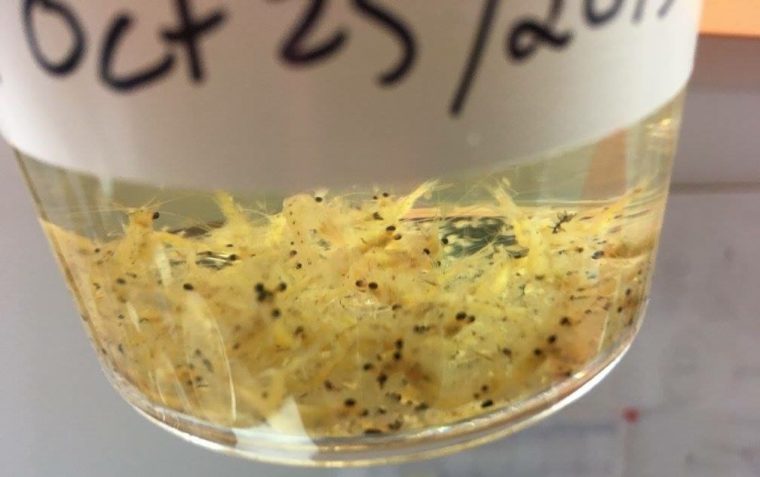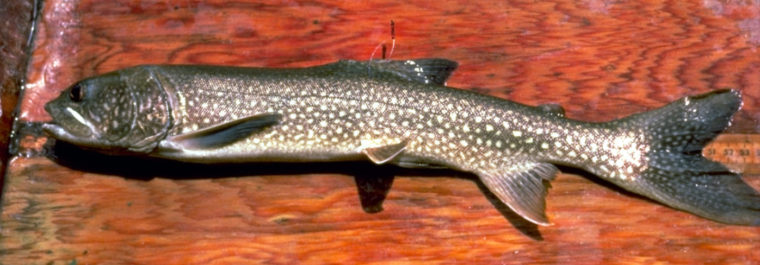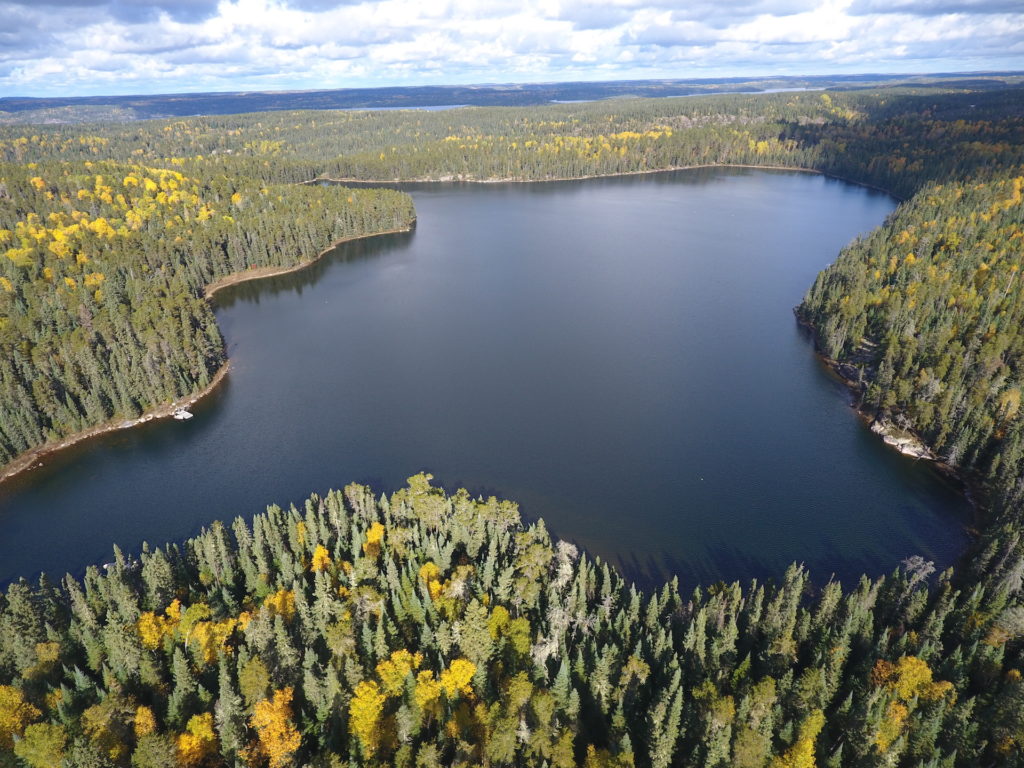
The Narwhal picks up National Magazine Award nomination for Amber Bracken’s oilsands photojournalism
Bracken was recognized for intimate portraits of residents of Fort Chipewyan, Alta., who told her...
Over the past year, Michael Rennie has dumped 30,000 tiny freshwater shrimp into a remote lake in northern Ontario.
Rennie, a freshwater ecologist at Lakehead University in Thunder Bay, is trying to find out if these shrimp can help the lake’s ecosystem recover from an environmental catastrophe that many people probably thought had already been solved: acid rain.
Anyone who was alive during the 1970s and ’80s in North America will remember acid rain as the big environmental issue of the time. Dead lakes, corroded statues and spiking rates of asthma made for compelling stories on the evening news. But as measures to deal with the pollution came into effect, the issue slipped from public consciousness, even though the story was far from over.
“Many people probably feel that we’ve solved acid rain, because there is a lack of awareness that the recovery will take a long time,” says Karen Kidd, an ecotoxicologist at McMaster University.

Scientists are experimenting with adding mysis shrimp back to a lake in northern Ontario, which has been used in experiments about the effects of acid rain. Photo: IISD Experimental Lakes Area
Acid rain forms when nitrogen oxide and sulphur dioxide gases are released into the atmosphere from the burning of fossil fuels. Those gases react with water molecules in the atmosphere to produce nitric and sulphuric acids, which then fall across the landscape as rain, snow and fog. The rain acidifies lakes and soils and corrodes buildings, while the nitrogen oxide and sulphur dioxide particles contribute to heart and lung problems. More acidic systems also tend to make mercury more available, and promote its uptake into the food web.
Aside from the lakes, acid rain also damaged the ground around them, leaching minerals like calcium and magnesium out of the soil, reducing the land’s ability to buffer the system. This was especially damaging in Atlantic Canada, where Kidd does most of her research, because the region’s many bogs meant the soils and waters were already naturally more acidic, so they started with even less neutralizing capacity.
“The chemical recovery happens fairly quickly, but the biological recovery lags behind.”
At the time, it seemed like an intractable problem. The vested industrial and economic interests involved were too strong, and the damage too severe to reverse.
“It seemed like a hopeless issue,” says John Gunn, a fisheries biologist at Laurentian University in Sudbury who has been studying the effects of acid rain for more than 30 years. “There were hundreds of damaged lakes, the complete collapse of the sport fishery.”
But a combination of scientific evidence and public pressure succeeded in forcing industry to clean up its act. The 1990 Clean Air Act Amendment in the United States and the 1991 Canada-U.S. Air Quality Agreement set strict limits on emissions and set up a cap-and-trade program to encourage companies to adopt cleaner technologies. The amount of acid rain falling in the U.S. and Canada dropped dramatically.
“It’s been a big success story,” says Gene Likens, an ecologist at the University of Connecticut who first discovered the effects of acid rain in 1963 at the Hubbard Brook Experimental Forest in New Hampshire. “At Hubbard Brook the acidity is now 80 per cent less than it was in the 1960s.”
Without new inputs of acid, many lakes and streams were able to return to their previous, more neutral, composition. But other parts of the ecosystem do not bounce back so easily.
“The chemical recovery happens fairly quickly, but the biological recovery lags behind,” says Rennie. So he is looking for ways to give it a boost.
In the 1970s scientists acidified lake 223, at the Experimental Lakes Area in northern Ontario near Kenora, in an experiment to study the effects of acid rain on ecosystems. They found that while larger fish like lake trout weren’t directly affected by the lower pH, many of the things they eat, such as crayfish, fathead minnows and mysis shrimp, were wiped out, so the trout starved. Pictures of those starving trout were part of what helped to convince politicians to act on acid rain.

A healthy trout. Photo: IISD Experimental Lakes Area

A starving lake trout from acidified lake 223 at the Experimental Lakes Area. Photo: IISD Experimental Lakes Area
When the lake was restored to its natural pH level after the experiment, most of those prey species recovered. But not the mysis. Today, more than 30 years later, the trout in lake 223 are smaller, grow more slowly and have higher levels of mercury than those in neighbouring lakes, all because they don’t have the shrimp to eat.
“What if we put them back? Would it help the trout?” asks Rennie.
Rennie and his team are trying to answer that question. Each spring and fall for three years they will add 10,000 shrimp to the lake. Then, after waiting a couple of years to see if the shrimp can re-establish a breeding population, they will check to see if the trout are getting healthier. If so, restocking missing species could be a technique to help speed the recovery of other lakes affected by acid rain.
Because the lake is part of the long-term research at the Experimental Lakes Area, Rennie knows exactly what the ecosystem looked like before the lake was acidified, so he has a target to shoot for in restoring it.
“This is one of the rare instances where we know what used to be there, so it is okay to put it back,” he says.

Lake 223 at the Experimental Lakes Area in northern Ontario. The lake has been used to study the effects of acid rain. Photo: IISD Experimental Lakes Area
Not every lake’s history is as well documented as that of lake 223, though. So Rennie is also testing a method of reconstructing the past conditions for lakes without that documented history. He is looking at environmental DNA – the genetic traces left behind by long-dead organisms – in sediment cores from the bottom of the lake. If those match up with lake 223’s historical record, the same technique could be used to see into the past of other lakes, and figure out what creatures are missing today.
“We could use sediments to see what the lakes looked like before, and use that as our restoration target,” he says.
It might prove impossible to return the damaged ecosystems to their historical state, of course. The loss of neutralizing minerals from the soil has left many in an extremely fragile state, Likens says, comparing it to someone with heartburn who has lost all of their Tums and Rolaids. Even a small amount of backsliding could undo 30 years of recovery.
“If we were to increase emissions again in these poorly buffered systems, the effects could be very large,” he says.
“When we were faced with what everybody described as irreversible damage, that proved not to be true.”
And in the decades since the lakes were ravaged by acid rain they have also been hit by another environmental disaster, climate change, which may mean it is not possible to get the ecosystem back to the way it was before.
“The climate may have changed enough already that it is no longer suitable for the organisms we want to bring back,” says Rennie.
The success of the efforts to control acid rain leave many scientists optimistic for the fight against climate change. The root cause of the problem — the burning of fossil fuels — is the same, and so are many of the solutions.
“We came together to make effective regulations and forced industry to adopt cleaner technologies, which made them more profitable,” says Gunn.
And the recovery shows that the earth has the resilience to bounce back from an insult, even if it might take decades, he adds.
“When we were faced with what everybody described as irreversible damage, that proved not to be true.”
Get the inside scoop on The Narwhal’s environment and climate reporting by signing up for our free newsletter. Angello Johnson’s shoulders burn, and his arms...
Continue reading
Bracken was recognized for intimate portraits of residents of Fort Chipewyan, Alta., who told her...

A guide to the BC Energy Regulator: what it is, what it does and why...

The B.C. government has introduced legislation to fast track wind projects and the North Coast...
